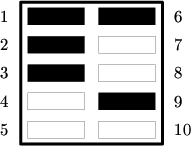Difference between revisions of "1988 AIME Problems/Problem 1"
m (→Solution: fix typo) |
m (space) |
||
| Line 1: | Line 1: | ||
== Problem == | == Problem == | ||
One commercially available ten-button lock may be opened by depressing -- in any order -- the correct five buttons. The sample shown below has {1,2,3,6,9} as its combination. Suppose that these locks are redesigned so that sets of as many as nine buttons or as few as one button could serve as combinations. How many additional combinations would this allow? | One commercially available ten-button lock may be opened by depressing -- in any order -- the correct five buttons. The sample shown below has {1,2,3,6,9} as its combination. Suppose that these locks are redesigned so that sets of as many as nine buttons or as few as one button could serve as combinations. How many additional combinations would this allow? | ||
| + | |||
[[Image:1988-1.png]] | [[Image:1988-1.png]] | ||
== Solution == | == Solution == | ||
Revision as of 20:48, 28 September 2007
Problem
One commercially available ten-button lock may be opened by depressing -- in any order -- the correct five buttons. The sample shown below has {1,2,3,6,9} as its combination. Suppose that these locks are redesigned so that sets of as many as nine buttons or as few as one button could serve as combinations. How many additional combinations would this allow?
Solution
Currently there are ![]() possible ways.
With any number from 1 to 9 the number of ways is
possible ways.
With any number from 1 to 9 the number of ways is  .
Now we can use the identity
.
Now we can use the identity  .
So the difference in the number of ways is just
.
So the difference in the number of ways is just

See also
| 1988 AIME (Problems • Answer Key • Resources) | ||
| Preceded by First Question |
Followed by Problem 2 | |
| 1 • 2 • 3 • 4 • 5 • 6 • 7 • 8 • 9 • 10 • 11 • 12 • 13 • 14 • 15 | ||
| All AIME Problems and Solutions | ||










